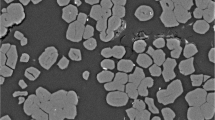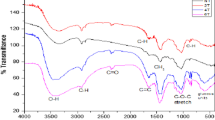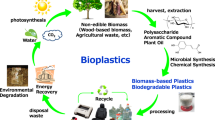Abstract
The potential capacity of microorganisms to form fibre structures, fibre- and film-forming polymers, and the monomers for their chemical synthesis was analyzed. The applied aspects of fabrication of oriented polymer materials (fibres and films) from the cellular biomass of fungi, bacteria, individual products of cell metabolism (organic acids, amino acids), and biopolymers (enzymes) were examined. The role of microbial technologies in utilization of the new raw material resources for fabrication of fibres and films, in improving production of existing types of fibres, and in creating new types of fibre materials of natural origin was evaluated.
Similar content being viewed by others
References
V. A. Bykov, Biotekhnologiya, No. 6, 692–700 (1987).
M. R. Baker, A. N. Emery, and C. S. Easthope, “Modelling oxygen uptake in mycelial suspensions using microfibres of immobilised bacteria,≓ in: Proc. 4th Eur. Congr. Biotechnol., Vol. 1, Amsterdam (June 14–19, 1987), pp. 218–221.
“Biotechnologie in textilen Prozessen,≓ Textiltechnik,36, No. 12, 696–697 (1986).
I. Higgins, D. Best, and J. Johnson (eds.), Biotechnology: Principles and Application [Russian translation], Mir, Moscow (1988).
N. H. Mendelson, Bioprocess. Technol.,12, No. 1, 6 (1990).
“Textile industry to explore biopigments and use microfungal filaments in wound dressing,≓ Biotechnol. Bull.,8, No. 12, 8–9 (1990).
D. S. Kenney and S. H. Woodhead, Dev. Ind. Microbiol., Vol.24, Proc. 39th Gen. Meet. Soc. Ind. Microbiol., St. Paul Minn., Aug. 14–20, 1982, Arlington Va. (1983), pp. 31–43.
Dr. Sagar, “Biotechnology and textile industry,≓ Colourade,30, No. 14, 41–42 (1983).
A. Ya. Teslenko and V. G. Popova, “Chitin and its production in biotechnology,≓ Data Sheet, Ser. V., Preparation and Use of Enzymes, Vitamins, and Amino Acids [in Russian], No. 3, Moscow (1982), p. 44.
N. P. Elinov, Usp. Mikrobiol., No. 17, 158–177 (1982).
N. G. Rybal'skii and O. M. Komarova, Biotechnology of Polysaccharides [in Russian], Biotechnology Ser., VNIIPI, Moscow (1990).
“Microbes make polysaccharides from hemicellulose,≓ Bioprocess Technol., No. 6, 6–67 (1989).
A. Ya. Ozola, I. G. Veinberga, et al., Izv. Akad. Nauk Latv. SSR, No. 5, 96–98 (1988).
S. Yuens, Proc. Biochem.,9, 4–9 (1974).
C. W. Gooday, Propr. Ind. Microbiol., Amsterdam, No. 35, 127 (1983).
G. Annison and L. Canperwhite, Austral. J. Bio. Sci.,40, No. 4, 435–441 (1987).
L. I. Vorob'eva, Industrial Microbiology [in Russian], Izd. MGU, Moscow (1989).
I. F. Kennedy and C. A. White, Bioactive Carbohydrates in Chemistry, Biochemistry and Biology, Ellis Horwood, New York (1983), pp. 98–308.
R. I. Gvozdyak, M. S. Malyshevskaya, et al., The Microbial Polysaccharide Xanthate [in Russian], Naukova Dumka, Kiev (1989).
K. Sattler and S. Fiedler, Zbl. Mikrobiol.,145, No. 4, 247–252 (1990).
M. Takai, F. Nonomura, and T. Inuki, Fibre,47, No. 3, 119–129 (1991).
“Recombinant industrial polymers: feasible for special applications,≓ Genet. Technol. News,7, No. 3, 6–7 (1987).
“Bioengineers produce spider silk fromE. coli,≓ Curr. Comments: Newsletter. Discovery and Innovation,2, No. 11, 4 (1988).
E. Murray, M. Donald, et al., Production of Protein Fibre, Canadian Patent No. 1103307, filed on February 3, 1978, published on June 30, 1981.
“Biodegradable plastics update,≓ Bioprocess Technol.,10, No. 6, 3–6 (1988).
A. M. Bezborodov, Enzymatic Reactions in Biotechnology: 48th Bakhov Reading [in Russian], Nauka, Moscow (1994).
Yoshiharu Doi, Akira Tamaki, et al., Appl. Microbiol. Biotechnol.,28, No. 25, 330–334 (1988).
T. R. Burrow and P. R. Laity, “Novel routes to the manufacture of polysaccharide fibres,≓ in: World Biotechn. Rept. 1986: Proc. Biotechn. 86, London, May 1986, Vol. 1, London, New York (1986), pp. 201–209.
Shaped Solid Article from Pullulan Ether, Method of Its Preparation, and Area of Application, US Patent No. 3870537, Int. Cl. C 08 B 25/00, filed on February 25, 1974, published on March 11, 1975; RI IZR, No. 4, 19 (1975).
T. Harada, “Production, properties and application of curdlan extracellular microbial polysaccharides,≓ in: ACS Symp., Ser. 45, Washington (1977), pp. 265–283.
S. V. Gorokhova, I. I. Shamolina, and E. P. Anan'eva, Khim. Volokna, No. 3, 57 (1992).
S. V. Gorokhova, I. I. Shamolina, and V. F. Danilichev, “Microbial polysaccharide films,≓ in: Proceedings of the All-Union Conference Results and Prospects for Scientific Research in Biotechnology and Pharmaceutics [in Russian], Leningrad (1989), pp. 129–130.
S. Kawasaki, J. Jpn. Soc. Food Sci. Technol.,31, No. 2, 72–78 (1984).
I. P. Dobrovol'skaya, N. L. Kuz'mina, et al., Khim. Volokna, No. 5, 18–19 (1992).
G. K. Liepin'sh and M. E. Duntse, Raw Material and Nutrient Substrates for Industrial Biotechnology [in Russian], Zinatne, Riga (1986).
“Production of biodegradation polylactide plastic,≓ Chem. Eng.,96, No. 2, 19 (1989).
“Synthesis of nylon raw materials using biotechnology,≓ CEER, Chem. Econ. Eng. Rev., Nos. 1–2, 35–36 (1986).
S. J. Barer, P. C. Maxwell, and J. H. Hsieh, Production of Nylon 6.6 Salt, US Patent No. 4725542, Int. Cl. C12P13/00, filed on January 13, 1983, published on February 16, 1988.
T. Hayaschi, J. Takanashi, and A. Nakajima, J. Soc. Fibre, Sci. Technol. Jpn.,43, No. 9, 462–470 (1987).
“Novo solves pollution problems in caprolactam synthesis,≓ Bioprocess. Technol.,8, No. 10, 7 (1986).
E. Ya. Vaiman, L. S. Gerasimova, et al., Khim. Volokna, No. 6, 38–40 (1979).
Author information
Authors and Affiliations
Additional information
Translated from Khimicheskie Volokna, No. 1, pp. 3–10, January–February, 1997.
Rights and permissions
About this article
Cite this article
Shamolina, I.I. Prospects for use of microbial raw material for fabrication of fibre and film materials. Review. Fibre Chem 29, 1–8 (1997). https://doi.org/10.1007/BF02430677
Issue Date:
DOI: https://doi.org/10.1007/BF02430677




